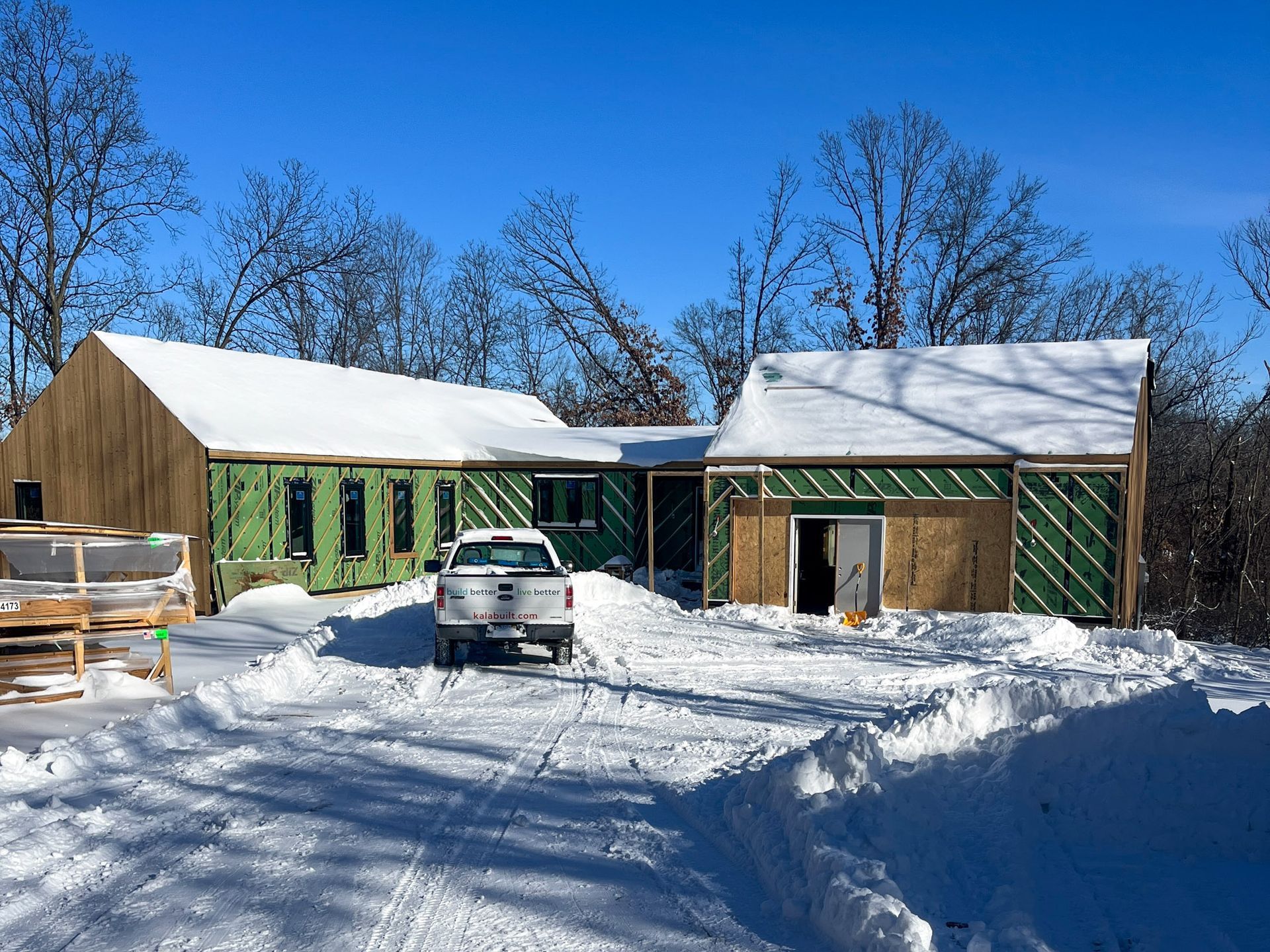How Passive House Building Improves Durability During Winter

Passive House Design & Build Improves Winter Durability
In the variable Kansas City climate, every season can pose a threat to the durability of a home. But winter conditions present particular challenges, from wintry precipitation forming and melting to temperature and humidity levels changing dramatically to air, moisture, and cold intruding. Let’s look at how Kala uses a Passive House design and build strategy to help homeowners preemptively tackle these issues and make a home more durable.
Managing Ice and Snowmelt
Water damage is arguably the biggest reason that many modern homes don’t last long. For the majority of the year, rain is the most significant weather-based water source that tests the durability of a home. But in winter, ice, snow, and sleet present unique challenges to the quality of the construction.
“When icicles hanging off the gutters melt, the water can leak inside the wall assembly,” said Kala co-founder and managing director David Schleicher. “This can cause rot to form and compromise the effectiveness of the insulation.”
To prevent this, Kala ensures that gutters and downspouts are sufficient to retain water and then channel it down, out, and away from the home if it turns to ice and then unfreezes. This prevents water from accumulating and seeping into the building enclosure. Thoughtful roof design delivers appropriate shading in a Passive House during summer, while allowing adequate sunlight to come through and help heat the home via passive solar in winter. Schleicher said that this feature is also key to managing moisture during colder months.
“You have to think about the angles of the roof as it relates to getting water off and away from the home,” he said. “Large overhangs will help ensure that any snow and ice melt that the gutters don’t catch won’t run down the walls and soak into them.”
Keeping Cold Air and Moisture Out
Another way that water can invade a traditional home is through air movement in the wall assembly. Typically, there is excessive airflow through cracks and gaps. This allows wintry conditions to intrude on the inside, creating cold spots and causing the furnace to run constantly in a futile effort to keep up. Some of the warm air it is circulating leaks out, creating a vicious cycle.
Cold air leaking in and warm air escaping out doesn’t merely reduce comfort during winter. Anytime air can flow one way or another, moisture comes with it. When this moisture gets into the building envelope, it can undermine the integrity of the framing, cause mildew and mold buildup, and greatly reduce the benefits of insulation. As a result, the home doesn’t last as long. Eventually, long-term maintenance like costly siding repair or mold removal might be necessary.
To prevent this, Kala includes control layers that manage moisture and air simultaneously. Tightly sealing the building envelope keeps cold air out and warm air in. Features such as a ventilated rainscreen and weather-resistant barrier prevent moisture buildup and allow any water that does find its way into the wall assembly to dry out.
“Snow and ice on top of a roof can leak into an attic,” Schleicher said. “Using high-grade roofing materials, tightly sealing this space, and creating an air and moisture barrier in the bottom of the attic that separates it from the living space prevents moisture from forming.”
Windows are another durability weak point that is often exposed during winter. If you’ve ever noticed condensation or frost on the inside or felt a chilly draft, then you’ve seen how easily cold air and moisture can intrude. To prevent this, Kala ensures windows are carefully installed within the thermal control layer. Features like triple panes, gasket sealing, and flashing eliminate drafts, improving the living experience and ensuring the inside of every window and the wall below it stays dry. But even the best, most efficient, windows have to be installed with care and precision.
“It can be the dead of winter and I’ll walk around in shorts and a t-shirt and be totally fine and comfortable,” said Pooja Bhadbhade, whose Kala home is the first certified Passive House in Missouri.
Tackling Thermal Bridges
The durability of a regular home’s building envelope is also compromised during winter by thermal bridges. These occur when the thermal layer is penetrated by a highly conductive material, which lets heat flow through it. Examples include exterior balconies anchored on the interior, wall studs, and rim joists. Windows and doors are also prime culprits for thermal bridges.
So why is it an issue? They cause the kind of cold interior surfaces that you’re probably all too familiar with. When surface temperature falls below the dew point of the interior air, this creates condensation, which in turn leads to mildew, rot, and mold formation. Over time, these seriously reduce the durability of the home, as well as compromise the comfort and health of its occupants.
These effects also occur in other areas of the home. Examples include uninsulated foundation slabs and walls and structural elements that come through the roof and upstairs ceiling, such as chimneys, vents, and skylights. The more thermal bridges that occur, the greater the negative impact on durability.
Passive House construction principles used by builders like Kala tackle this durability issue on all six sides of a home. Using thermally broken window and door frames helps prevent moisture from forming around them. Eliminating penetrations of the thermal layer by highly conductive materials and replacing them (when possible) with those that transfer less heat energy also helps prevent cold interior surfaces and resulting moisture buildup. Kala’s expert in-house framing team works with our architecture team to ensure that the wall assembly itself is as thermal bridge-free as possible.
By utilizing an efficient building envelope that minimizes framing in the walls, Kala is able to integrate an unbroken thermal control layer. Continuous insulation throughout the walls and above and below the main living areas wrap the home in the equivalent of a down jacket, which, thanks to the vapor-open airtight barrier mentioned earlier, also offers protection similar to Gore-Tex. As a result, the house lasts longer and homeowners are protected from the elements so they can stay cozy even during extreme winter weather.
“You can feel better durability because there are no cold spots or drafts during winter,” Schleicher said. “You should be able to occupy and enjoy every inch of the house 24/7, 365 days a year and each room and floor should be comfortable.”
“There’s very little variability when you walk up or downstairs,” said Kala homeowner Morgen Govindan. “It’s just consistent throughout.”
Protecting Pipes
An additional benefit of including plentiful and well-integrated insulation in a Passive House is that it can prevent pipes from bursting. According to an article by This Old House, this happens in winter when pipes are exposed to temperatures below 55 degrees. As it expands when frozen, the trapped water puts pressure on the pipe, and this leads to a crack.
The thermal control layer in a Passive House goes a long way to preventing this from occurring, as the water in the pipes isn’t exposed to outdoor cold. With the kind of thoughtful building approach Kala uses, placement is also key. Unlike in a traditional build, pipes are placed inside insulated spaces, which ensures water keeps flowing without freezing. And there’s no need to winterize if a homeowner is gone for a long time. The combination of all these high-performance features leads to a Passive House providing greater durability and peace of mind during even the coldest conditions.




